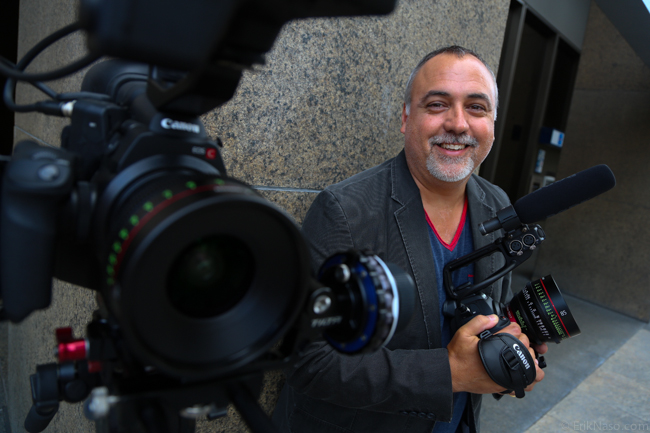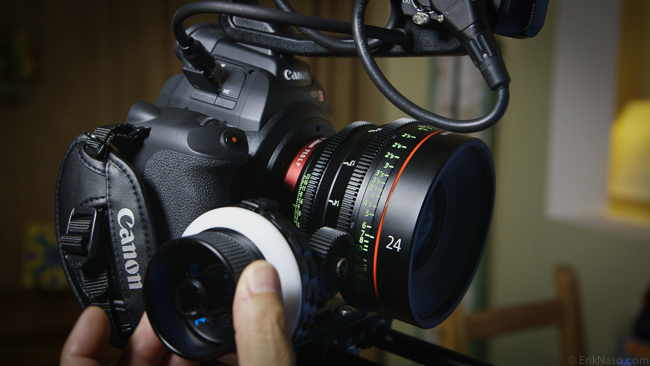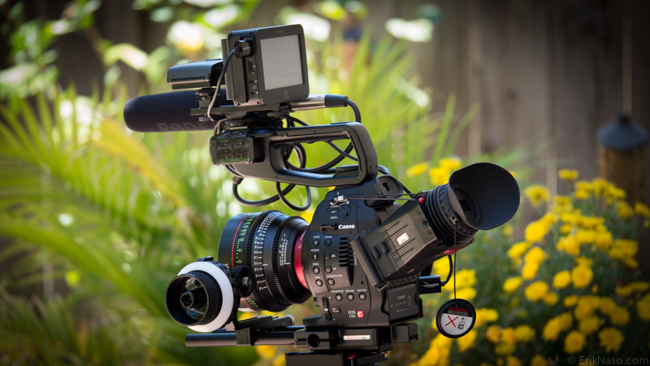Canon CN-E Cinema Primes Hands On Review
What do say when you get a email that reads. Erik. Would you be interested in reviewing the Canon CN-E Cinema Primes? Heck yes is what I said!. That’s pretty much how it went. Terry Nixon at Texas Media Systems sent me an email just like that. I think he was on a mountain bike in Utah when he sent that email But I digress. Thanks Terry for setting this up with Canon USA so I can play around with these lenses.
The Canon cinema primes are full frame lenses so they will cover a 5D MKIII and EOS-1D C as well as S35 sensors like the Canon Cinema EOS line. Generally prime lenses are the sharpest and cinema primes are going to be the best of the best.
The CN-E primes are not available in a PL mount. EF only. This might not be as big of an issue these days since Red offers an EF mount, and Sony has an adapter available. I understand Duclos is working on a PL adapter for the EF mount. If your an ARRI Alexa kind of guy these wont work for you. The build on these are nice and solid. They have that“I’m going to last a long time” feel to them.
The focus and iris are nice and smooth. This is where these lenses really shine. The rotation is a nice and long 300° for precise focus. Sometimes it might be to long. Just add a crank to your follow focus for the big rack!
Modern stills lenses are deigned for auto focus so the throw on them are very short and usually don’t have a smooth resistance for precise manual focus. Manual focus lenses do have a better feel and longer throw so they’re a good alternative. All lenses breath and stills lenses breath the most. They’re just not designed for motion. I feel the CN-E primes perform very well as far as breathing is concerned.
A simple put helpful feature is the small raised red dot on the mount to help you quickly line up to the cameras EF mount. Similar to the Canon L lenses.
The gears are uniform on all the Canon CN-E primes making lens changes with a follow focus attached easier. No readjusting after lens changes.
A nice feature is how the markings on the lenses are on both sides. If you have a focus puller they can see the distance and iris settings from the right side making it super easy to adjust. I tested the distance marks and yes they’re spot on.
While I was checking out the front optics on the 85mm I was surprised to see what looks like threads so I grabbed a 72mm ND filter and look at that! It’s threaded. This is cool. If you don’t have or just don’t need to use a matte box just screw in a filter like a popularizer or ND filter. This is a huge time saver and will also save weight on your rig. The 24mm doesn’t have any threads and since I didn’t have the other focal lengths I don’t know if they have threads on the front. Obviously this option would only be for the 85mm but I did find it interesting.
Of the two I have to say the 85mm is my favorite, but that seems to be the case more often than not. Don’t get me wrong. The 24mm is nice and sharp. But the longer focal length is just fun to shoot with. Nice separation from the background makes your subject pop!
The CN-E line all have an 11 blade iris. This creates some really nice bokeh. The 24mm is no slouch! I got some nice wide shots and the image looked really great.
The lenses have electronic contacts on the mount. The only viewable data that the LCD and viewfinder show are the T-Stops. However they show as F-Stops. It would be nice if the focus distance information was also available.
The 85mm has a big front element. Look at the Zeiss CP.2 compared to the Canon CN-E prime. It’s a faster lens at T1.3. The front of all the lenses are uniform at 114mm. This is nice if your using a matte box so you don’t have to change your donuts out. The 85mm weighs in at 2.87 lb. and the 24mm is 2.65 lb.
As for lens breathing I didn’t see any issues. I did a few rack focus in the sample video and they are very acceptable.
The Canon CN-E Primes are very nice sharp lenses with fantastic mechanics and image quality. It was a little difficult to only have only two lenses to shoot with, but I did my best. I did shot several sun shots and liked the way the lenses flared. They are fairly light and the EF mount makes them compatible with a full line of EOS cameras and other cameras that can you can get an EF adapter for.
Here is the setup I had when I went out to shoot with the C100 and CN-E lenses.
The interesting thing for me is that Canon decided to make cinema lenses in the EF mount. This tells me they are committed to the Cinema EOS line and hopefully make your investment in these lenses worth it. By making them full frame they will last a good long time as resolution and sensor sizes grow. The digital age is well underway. Another plus with full frame lenses on croped sensors is your using the sweet spot on the lens. The center and edges or corners tend to go soft but if your sensor is smaller than your lens you will never see the corners.
So far the CN-E line up looks like this and the cost around $5000 per lens.
- Canon CN-E 14mm T3.1 L F Cinema Prime Lens
- Canon CN-E 24mm T1.5 L F Cine Lens
- Canon CN-E 50mm T1.3 L F Cine Lens
- Canon CN-E 85mm T1.3 L F Cine Lens
- Canon CN-E 135mm T2.2 L F Cinema Prime Lens
One missing lens is a 35mm. I’m sure one will coming. It’s a very popular focal length.
My time with the CN-E Cinema primes was way to short and I wish I could have done more clinical testing but then that would have been all I could have done. I found this on The Australian Cinematographers Society website. They did a nice job shooting charts and comparing the the CN-E’s to Ultra Primes and CP.2’s Definitely worth checking this out.
That wraps up this review I really enjoyed shooting with the Canon Cinema Primes. These are true cinema lenses designed to perform. I think they share the same warm Canon L lenses look and I think that’s a good thing.
Thanks for coming by! Please help support my site by using the links on this page or bookmark these from my favorite retailers, B&H, Adorama, Zacuto & Amazon.com . Using the links cost you nothing extra, but helps offset the cost of running my blog. Thanks again for coming by eriknaso.com!
Filed in: 35mm Lens • C100 • C300 • Canon • Equipment Reviews • Lens Talk • New Release • PL Lens




















Great article Erik, as always. Thank you for the supporting links as well!
Hi Erik:
Those primes look really nice. Thanks for the review. Also I am impressed w/ the sound you captured in the video of the dancers. What was your sound set up?
Best,
Jon
Hi JP.
I used a Rode NTG1 shotgun mic attached to the camera. the trick to getting continuous clean audio is to roll longer takes. I started off from the left side and then popped off the tripod and walked over to the violin player and he started to do a solo. I think the camera motivated him. You will notice the violin gets more isolated since I was about three feet from him.
Wow. I woulda thought it was captured on a separate recorder it seemed so seamless especially knowing you were moving around.
When are you going to offer a workshop? Sign me up!
Erik –
Love your content and recommendations! I’m an aspiring doc shooter but starting with mostly weddings. My setup is two GH4s and one A7sii for extreme low light. I have a hard time finding any footage online of the GH4+Metabones+Canon cinema primes. Two questions: Have you tried this combo and what are you thoughts? Would you invest in these for optical quality over Canon L-glass or primarily for hard stops and manual aperture control?
Best regards –
Hey Erik,
It’s been almost 10 years, still feel the same about these lenses? Looking to pick up a used kit and had our eyes on the Xenons but at the price we found a kit of CN-E we’re leaning that way now.